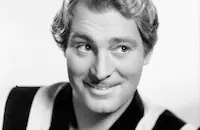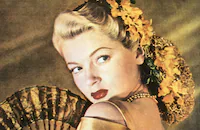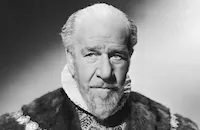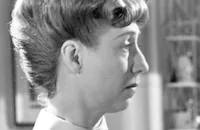Dramatic School

Brief Synopsis
Cast & Crew
Robert B. Sinclair
Luise Rainer
Paulette Goddard
Alan Marshall
Lana Turner
Genevieve Tobin
Film Details
Technical Specs

Synopsis
Although she is the most dedicated and talented student in Madame Charlot's class at the National School of Dramatic Arts in Paris, Louise Mauban is constantly getting into trouble for falling asleep during her lessons. Some of the other girls in school try to befriend her and ask her to go out to parties with them, but Louise always refuses, claiming that she has other social engagements. Actually, at night Louise works at a factory to earn enough money to attend school and falls asleep in class because she is exhausted from hard work. One night, while on a slumming trip to help his actress friend, Gina Bertier, who wants to soak up color for a role as a poor working girl, the Marquis Andre D'Abbencourt comes to the factory where Louise works. Louise, who is attracted to Andre, begins to fantasize that they are lovers and enthralls her fellow students with exciting stories about their supposedly real romance. Nana, one of the students who is jealous of Louise's talent, is certain that she is lying, and to prove her point to the other girls she throws a party at the home of her rich lover, and invites both Andre and Louise. Nana and some of her catty friends are certain that Louise will be humiliated when Andre arrives and doesn't know the girl, but when a butler advises Andre that a Frenchman should not destroy a girl's romantic dreams, Andre kindly pretends that he is in love with Louise. Soon Andre really does fall in love with Louise and sets her up in her own swank apartment. Some time later, Andre begins to tire of Louise's constant devotion to the theater and her dramatic studies and she leaves him after learning that he has spent the night with someone else. One night, Gina, who is supposed to play the lead in Joan of Arc has a tantrum and refuses to play her part, and Louise is selected to go on in her place. She is a tremendous success in the role and is visited backstage by Andre who now recognizes the importance of her talent and wants her back. Despite her feelings for him, Louise sends him away because she realizes that her greatest love with always be the theater.

Director

Robert B. Sinclair
Cast

Luise Rainer

Paulette Goddard

Alan Marshall

Lana Turner

Genevieve Tobin
Anthony Allan

Henry Stephenson

Gale Sondergaard

Melville Cooper

Erik Rhodes

Virginia Grey

Ann Rutherford

Hans Conried

Rand Brooks
Jean Chatburn

Marie Blake
Cecilia Callejo

Margaret Dumont

Frank Puglia
Dorothy Grainger
Esther Dale
Maurice Cass
Marek Windheim
Eleanor Wesselhoeft
Ralph Faulkner
Melissa Blake
Paul Irving
Marion Burns
June Terry
Jill Dennett
Jacques Lory

E. Allyn Warren
Harry Lamont
Leon Belasco
Minerva Urecal
Dorothea Wolbert
Jules Cowles
Max Barwyn
Gino Corrado
Virginia Dabney
Judith Ford
Pedro De Cordoba

Leonard Mudie
John Picorri
Barbara Weeks
Valerie Day
Priscilla Totten

Ona Munson
Anita Camargo
Norma Thelan
Mimi Doyle
Alene Carroll
Robin Page
Marcelle De Beauvolers
Carol Parker
Kay Stewart
Marta Downs
Ocean Claypool
Ruth Adler
Beryl Wallace
William Tannen
Arthur Gardner
Louis Aldon
Lyle Maraine
Warren Mccollum

Dick Haymes
Edward Arnold Jr.
Jack Daniels
Roy Bush
Edward Price

Bob Parrish
Eric Efron
George Travell
William Stelling
Crew
Adrian
Tom Andre
Jacques Deval
Cedric Gibbons
Mervyn Leroy
Mary C. Mccall Jr.
Joseph Ruttenberg
Gabriel Scognamillo
Douglas Shearer
Frederick Y. Smith
Ernest Vajda
Franz Waxman
Keith Weeks
Edwin B. Willis

Videos
Movie Clip



Trailer
Film Details
Technical Specs

Articles
Dramatic School
Tagline for Dramatic School
The tagline for Dramatic School (1938) aptly describes the film's plot, concerning the struggles of acting students only one of whom (played by Luise Rainer) makes it to stardom. Rainer's on-screen success, however, was not mirrored by her career after this film's release, while some of her co-stars, most notably Paulette Goddard and Lana Turner, were headed for much greater fame and longevity.
The Austrian-born Rainer had shot to stardom at MGM after being discovered doing stage work in Berlin. Despite becoming the first actor to win back-to-back Oscars® -- for The Great Ziegfeld (1936) and The Good Earth (1937) -- her tremulous emotionalism was too far removed from the Hollywood norm for her star to burn long. Lacking the sensuality of such other European imports as Greta Garbo and Marlene Dietrich and the all-American charm of such perennial good girls as Loretta Young and Olivia de Havilland, she soon faded from sight. Just two years after her second Oscar® win, MGM shoved her into the leading role in Dramatic School when Greer Garson, slated to make her U.S. screen debut as the young actress, hurt her back and was unable to continue in the role. After Dramatic School, MGM had nothing further for Rainer, and she had no use for Hollywood. Thoroughly disenchanted, she walked out on MGM and relocated in the East, where she tried to salvage her marriage to liberal playwright Clifford Odets (studio head Louis B. Mayer had considered the marriage a liability). She would only return to the screen two more times, for the low-budget World War II film Hostages (1943) and a 1997 adaptation of Dostoyevsky's The Gambler.
The rest of the film's cast was hardly finished with Hollywood. Paulette Goddard shared star billing with Rainer on the basis of one previous starring role. But that particular part happened to be the lead opposite her off-screen lover Charles Chaplin in Modern Times (1936), and it certainly warranted the billing. At the time, Goddard was under contract to independent producer David O. Selznick, who had signed her partly because he was considering casting her as Scarlett O'Hara in Gone with the Wind (1939). She was still engaged in screen tests for the coveted role when MGM borrowed her to play the glamorous student who throws parties to help her colleagues hook up with wealthy benefactors. Gifted with vivacity and obvious physical charms, Goddard had already become a favorite of Selznick's board chair, Jock Hay Whitney, who regularly sent her gift baskets of gourmet foods. She usually shared these with the film's crew, inspiring them to put in extra time making her look her best in the picture. Her behavior ingratiated her to others at MGM. By the time Dramatic School had opened to tepid reviews and box office, she had lost the role of Scarlett to Vivien Leigh. That didn't stop MGM from offering her another plum role, this time in a hit, The Women (1939), which in turn brought her a starring contract at Paramount Pictures.
The film's other future star was Lana Turner. After being discovered by producer-director Mervyn LeRoy to play the sexually provocative murder victim in They Won't Forget (1937) at Warner Bros., she had followed him to MGM, which had offered LeRoy a much more lucrative contract. Unconvinced of Turner's star potential, Jack Warner declined to buy her contract from LeRoy. Her role as the most acid-tongued of Rainer's classmates in the same year she played a small-town temptress in Love Finds Andy Hardy, put her on the fast track at MGM.
Other up and comers in the cast included the girlfriend from the Andy Hardy series, Ann Rutherford, and, making their screen debuts, comedian Hans Conried and singer Dick Haymes. The studio even provided on-screen opportunities in bit parts for Edward Arnold, Jr. and Maxine Marx, the children of contract players Edward Arnold and Chico Marx, respectively. Ironically, the film also featured a supporting performance from one of Marx's most popular co-stars, Margaret Dumont, this time playing the school's pantomime teacher.
Critics dismissed Dramatic School as a pale imitation of RKO's much more successful Stage Door (1937), which had starred Katharine Hepburn and Ginger Rogers in roles similar to those now played by Rainer and Goddard. Although praising the cast, Variety's review included the prophetic note, "Story is a very unwise choice for Miss Rainer, and studio is apparently finding it difficult to supply her with proper material."
Producer: Mervyn LeRoy
Director: Robert B. Sinclair
Screenplay: Ernest Vajda, Mary C. McCall, Jr.
Based on the play School of Drama by Hans Szekely and Zoltan Egyed
Cinematography: William Daniels
Art Direction: Cedric Gibbons, Gabriel Scognamillo
Music: Franz Waxman
Principal Cast: Luise Rainer (Louise), Paulette Goddard (Nana), Alan Marshal (Andre D'Abbencourt), Lana Turner (Mado), John Hubbard (Fleury), Henry Stephenson (Pasquel, Sr.), Genevieve Tobin (Gina Bertier), Gale Sondergaard (Mme. Charlot), Melville Cooper (Boulin), Erik Rhodes (Georges Mounier), Virginia Grey (Simone), Ann Rutherford (Yvonne), Hans Conried (Ramy), Rand Brooks (Pasquel, Jr.) Marie Blake (Annette), Margaret Dumont (Pantomime Teacher), Minerva Urecal (Rose, Boulin's Secretary), Ona Munson, Dick Haymes (Students).
BW-80m.
by Frank Miller

Dramatic School
Virginia Grey (1917-2004)
She was was born in Los Angeles on March 22, 1917, and was exposed to the film industry at a very young age. Her father, Ray Grey, was a Keystone Cop and acted in several other of Mack Sennett's comedies with the likes of Mabel Normand, Dorothy Gish and Ben Turpin. When her father died when she was still a child, Virginia's mother encouraged her to join the acting game and audition for the role of Eva for Uncle Tom's Cabin, a big budget picture for Universal Studios in the day. She won the role, and acted in a few more pictures at the studio: The Michigan Kid and Heart to Heart (both 1928), before she decided to temporarily leave acting to finish her schooling.
She returned to films after graduating from high school, and after bouncing around Hollywood doing bits for various studios, she hooked up with MGM in 1938. Her roles in her first few films were fairly non-descript: In Test Pilot and Ladies in Distress (both 1938), she did little more than look pretty, but in the following year she had scene-stealing parts in The Women (upstaging Joan Crawford in a delicious scene as a wisecracking perfume counter girl) and as the suffering heroine in Another Thin Man (both 1939).
Despite her versatility (she could handle comedy or drama with equal effectiveness), MGM would cast her in some above-average, but hardly starmaking movies: Whistling in the Dark, The Big Store (both 1941), and Tarzan's New York Adventure (1942). She left MGM in 1943 and became a freelance actress for several studios, but her material as a leading lady throughout the '40s were mediocre: Swamp Fire, House of Horrors (both 1946), and Mexican Hayride (1948) were sadly the more interesting films in her post-MGM period. But by the '50s she was a well-established character actress, appearing in fairly big-budget pictures: All That Heaven Allows, The Rose Tattoo (both 1955), Jeanne Eagels (1957).
In the '60s, Grey turned to television and found work on a variety of hit shows: Wagon Train, Peter Gunn, Bonanza, My Three Sons, I Spy, and several others; plus she also captured a a couple of notable supporting parts in these films: Madame X (1966), and Airport (1970), before retiring completely from acting in the early '70s. She is survived by her sister, Lorraine Grey Heindorf, two nieces and two nephews.
by Michael T. Toole
Virginia Grey (1917-2004)
Quotes
Trivia
Notes
According to a Hollywood Reporter news item, Melville Cooper replaced Reginald Owen in the role of "Boulin" because Owen had to assume the role of "Ebenezzer Scrooge" in M-G-M's production of A Christmas Carol when Lionel Barrymore was forced to withdraw from that production because of illness. This was Luise Rainer's last film for M-G-M, the studio for which she had worked since her arrival in the United States four years previously. Actors Hans Conreid and Dick Haymes made their motion picture debuts in Dramatic School. Conreid remained a popular film and television character actor until his death in 1982. Haymes became a very popular singing star in the 1940s.















